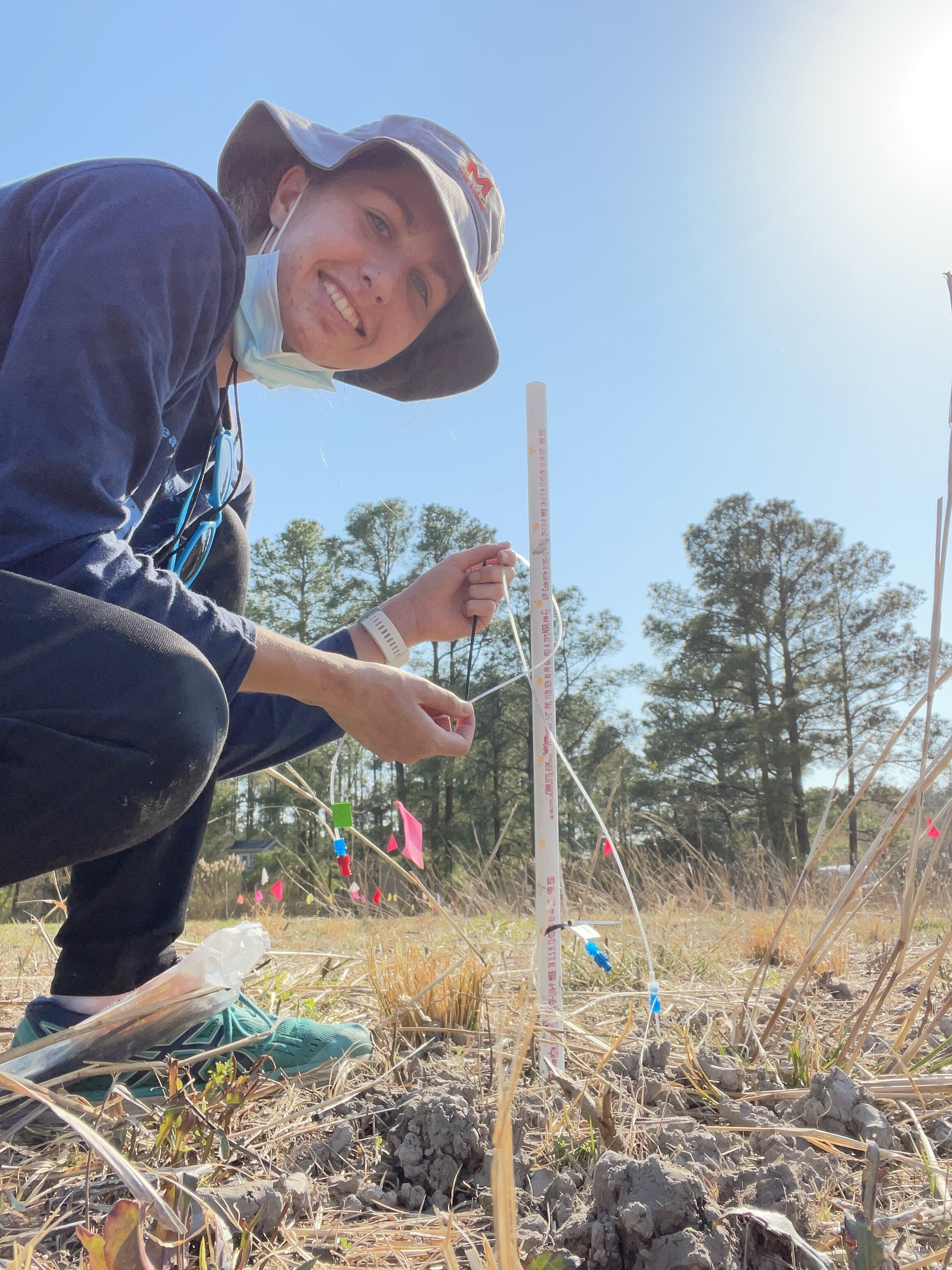Soil is charged
Sofia helping install rhizon porewater collectors.
Maryland is known for its well-drained, deep, and aged soil profile. This soil profile is suitable for productive uses, one of those being agriculture [1]. Through my work at the Tully Agroecology Lab, I am always learning something new about saltwater intrusion and its influence on the roles of Maryland coastal soils.
One of the most important roles of soils is being a source of nutrients for the organisms that live within it. Soils contain these nutrients because of the decomposition of organic matter through biogeochemical processes [2]. The organic matter and clay within a soil have a net negative charge [3]. A soil’s charge or its electrical conductivity (EC) is among “the most frequently used tools in precision agriculture research” because of its ability to determine soil qualities, such as soil salinity or clay content, presence of anthropogenic influences, and use in agricultural application [4].
I have recently begun to learn about measuring the EC of soils at the Tully Agroecology Lab. The soil samples that we have collected from coastal farms in Maryland are being measured for EC levels because it provides an indication of soil salinity content. This is relevant because of the saltwater intrusion that is increasing the soil salinity of the coastal agricultural systems. The salinity of soil refers to “the presence of the major dissolved inorganic solutes in the aqueous phase consisting of soluble and readily dissolvable salts in soil, including charged species (e.g., Na+, K+, …)” [5]. These charged salts loosen the soil’s grip on other charged species, such as species containing nitrogen and phosphorus, that are key for plant growth. An increase in soil salinity causes undesired effects such as crop yield declines and marsh migration [6].
In the lab, we are using the “1:5 aqueous extraction, EC, measurement” method [7] to measure the EC of the soil samples. In this method, soil samples are mixed with deionized water (that is free of ions or dissolved solutes). The soil samples are inverted and allowed to sit for 23 hours. The samples are then shaken on the shaker table for one hour and centrifuged for two minutes to continually break down the soil structure, allowing charged ions and solutes from the soil to dissolve into the water. With the soil samples now being soil slurries, they are filtered through a one micrometer glass fiber filter into a scintillation vial. This step separates the ions and dissolved solutes from the other contents that were part of the soil sample. The filtered solution containing the ions, dissolved solutes, and once deionized water, is then analyzed using the EC probe. The EC probe conducts an electric current through the solution to measure its conductivity and thus the EC of that sample.
References:
Cowherd W. D., (2021) Sassafras Maryland State Soil. Soil Science Society of America. https://www.soils.org/
Robertson, G. P., & Paul, E. A. (2000). Decomposition and soil organic matter dynamics. In Methods in ecosystem science (pp. 104-116). Springer, New York, NY.
Mengel, D. B. (1993). Fundamentals of soil cation exchange capacity (CEC). Purdue University Cooperative Extension Service West Lafayette, Indiana, USA.
Corwin, D.L., Lesch, S.M., (2005). Apparent soil electrical conductivity measurements in agriculture, Computers and Electronics in Agriculture. Volume 46 (Issues 1-3): Pages 11-45. https://doi.org/10.1016/j.compag.2004.10.005.
Corwin, D.L., Lesch, S.M., (2003). Application of Soil Electrical Conductivity to Precision Agriculture, Agronomy Journal. Volume 95 (Issue 3): Pages 455-471. https://doi.org/10.2134/agronj2003.4550.
Tully, K., Gedan, K., Epanchin-Niell, R., Strong, A., Bernhardt, E. S., BenDor, T., Mitchell, M., Kominoski, J., Jordan, T. E., Neubauer, S. C., Weston, N. B., (2019). The Invisible Flood: The Chemistry, Ecology, and Social Implications of Coastal Saltwater Intrusion, BioScience. Volume 69 (Issue 50): Pages 368–378. https://doi.org/10.1093/biosci/biz027.
Burt, R., (2011). Soil Survey Investigations Report No. 45 Version 2.0, United States Department of Agriculture, Version 2.0: Page 202. https://www.nrcs.usda.gov/Internet/FSE_DOCUMENTS/nrcs142p2_052226.pdf.

